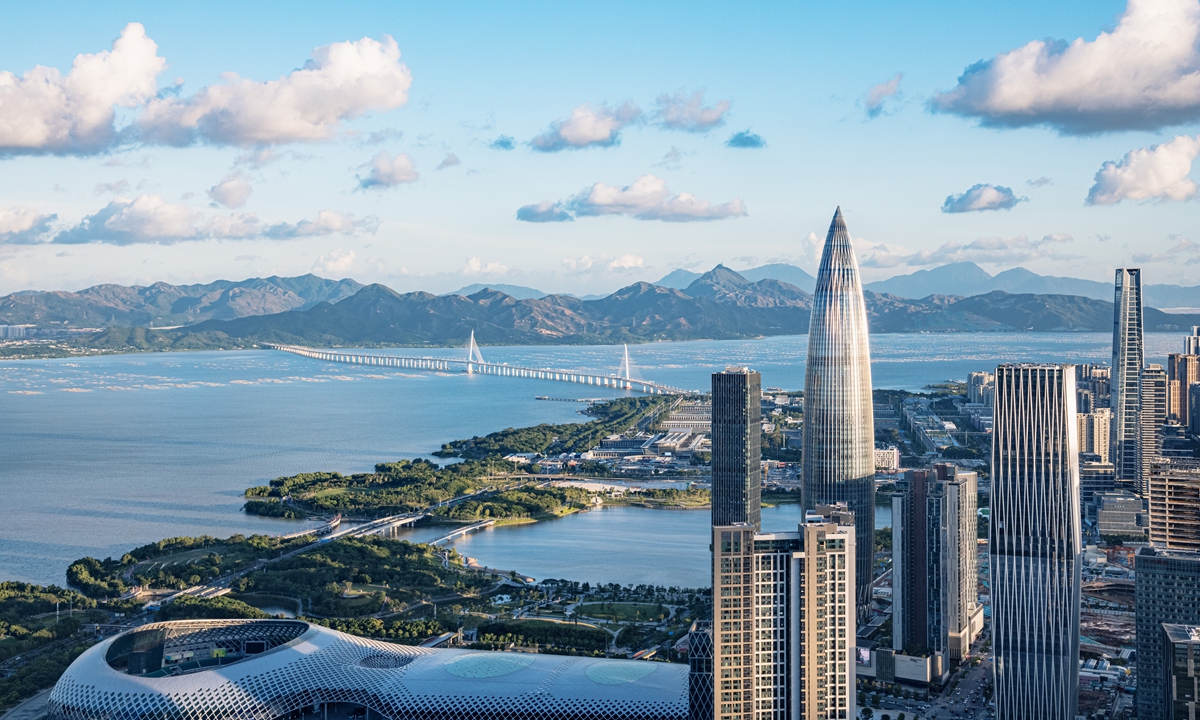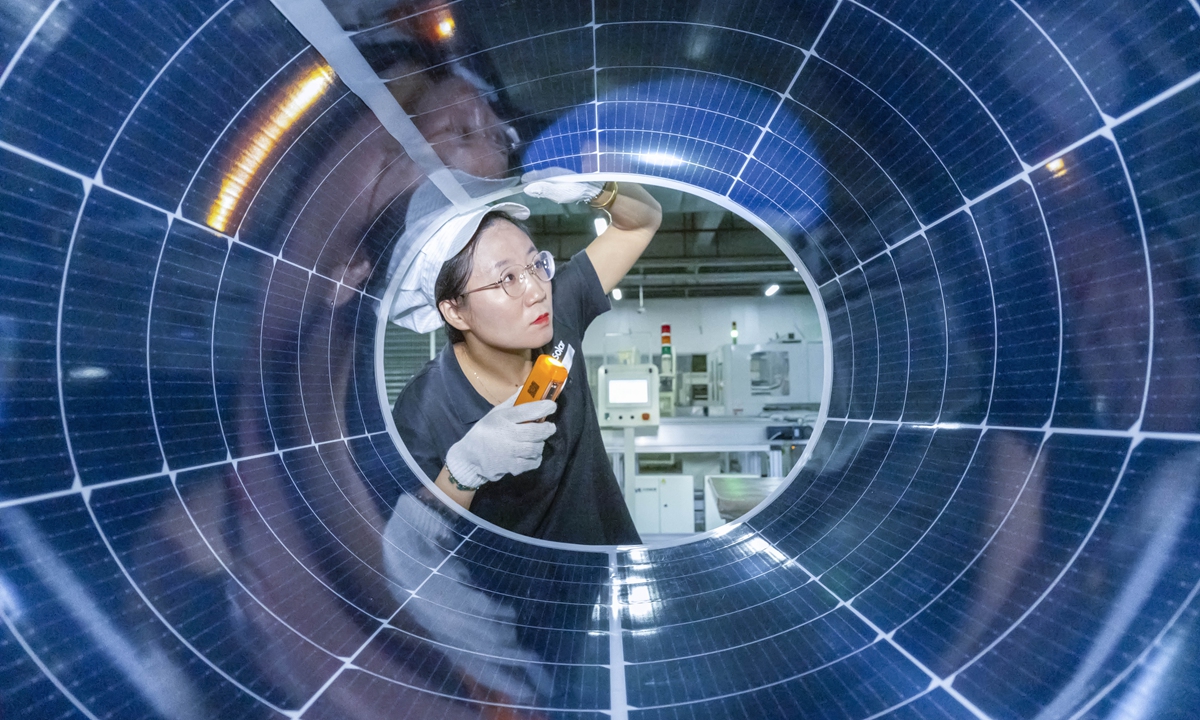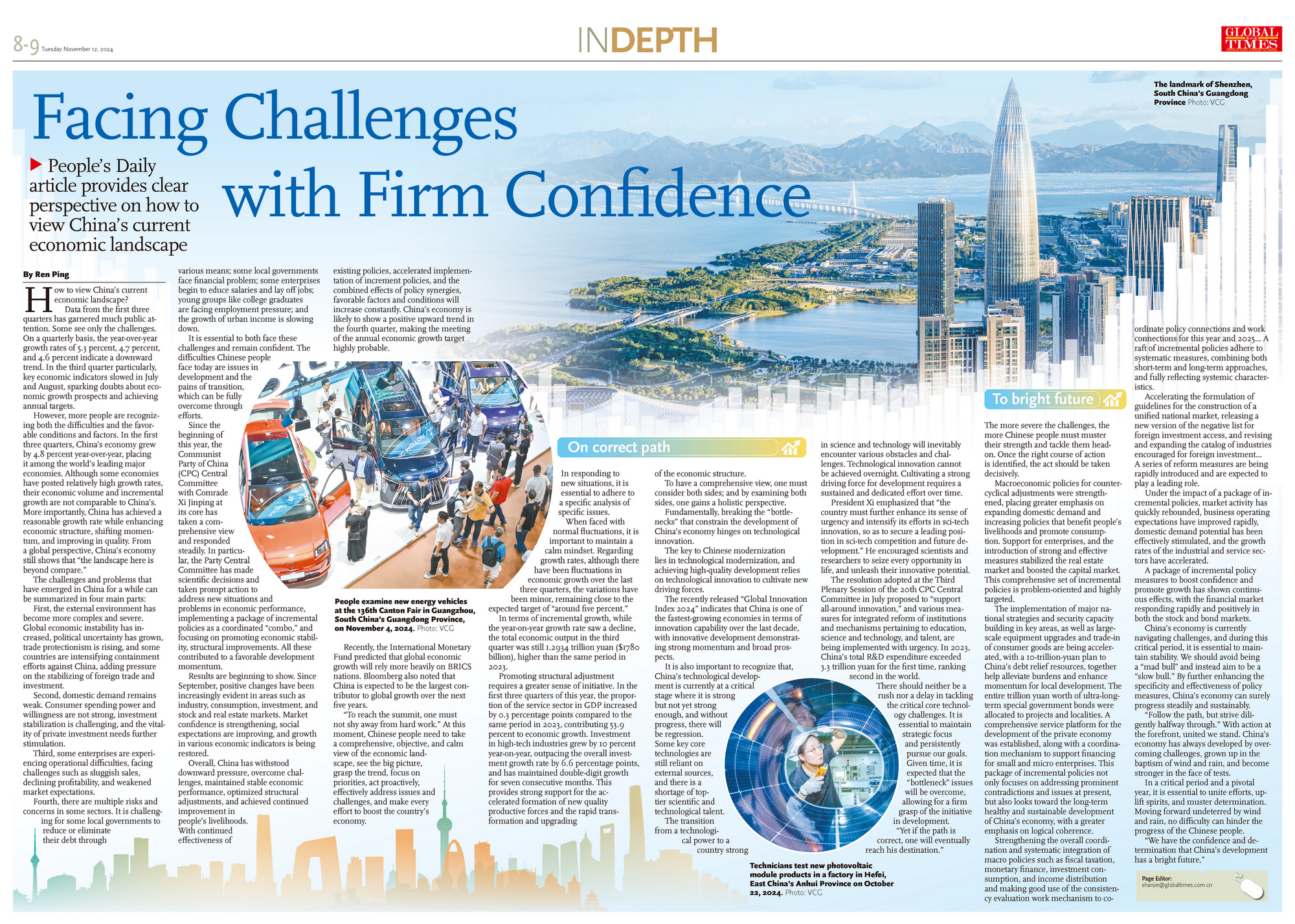
The landmark of Shenzhen, South China's Guangdong Province Photo: VCG
How to view China's current economic landscape?
Data from the first three quarters has garnered much public attention. Some see only the challenges. On a quarterly basis, the year-over-year growth rates of 5.3 percent, 4.7 percent, and 4.6 percent indicate a downward trend. In the third quarter particularly, key economic indicators slowed in July and August, sparking doubts about economic growth prospects and achieving annual targets.
However, more people are recognizing both the difficulties and the favorable conditions and factors. In the first three quarters, China's economy grew by 4.8 percent year-over-year, placing it among the world's leading major economies. Although some economies have posted relatively high growth rates, their economic volume and incremental growth are not comparable to China's. More importantly, China has achieved a reasonable growth rate while enhancing economic structure, shifting momentum, and improving in quality. From a global perspective, China's economy still shows that "the landscape here is beyond compare."
The challenges and problems that have emerged in China for a while can be summarized in four main parts:
First, the external environment has become more complex and severe. Global economic instability has increased, political uncertainty has grown, trade protectionism is rising, and some countries are intensifying containment efforts against China, adding pressure on the stabilizing of foreign trade and investment.
Second, domestic demand remains weak. Consumer spending power and willingness are not strong, investment stabilization is challenging, and the vitality of private investment needs further stimulation.
Third, some enterprises are experiencing operational difficulties, facing challenges such as sluggish sales, declining profitability, and weakened market expectations.
Fourth, there are multiple risks and concerns in some sectors. It is challenging for some local governments to reduce or eliminate their debt through various means; some local governments face financial problem; some enterprises begin to educe salaries and lay off jobs; young groups like college graduates are facing employment pressure; and the growth of urban income is slowing down.
It is essential to both face these challenges and remain confident. The difficulties Chinese people face today are issues in development and the pains of transition, which can be fully overcome through efforts.
Since the beginning of this year, the Communist Party of China (CPC) Central Committee with Comrade Xi Jinping at its core has taken a comprehensive view and responded steadily. In particular, the Party Central Committee has made scientific decisions and taken prompt action to address new situations and problems in economic performance, implementing a package of incremental policies as a coordinated "combo," focused on promoting economic stability, structural improvements. All these contributed to a favorable development momentum.
Results are beginning to show. Since September, positive changes have been increasingly evident in areas such as industry, consumption, investment, and stock and real estate markets. Market confidence is strengthening, social expectations are improving, and growth in various economic indicators is being restored.
Overall, China has withstood downward pressure, overcome challenges, maintained stable economic performance, optimized structural adjustments, and achieved continued improvement in people's livelihoods. Signs of economic transition from finding the bottom to stability, then to recovery are becoming clearer.
With continued effectiveness of existing policies, accelerated implementation of increment policies, and the combined effects of policy synergies, favorable factors and conditions will increase constantly. China's economy is likely to show a positive upward trend in the fourth quarter, making the meeting of the annual economic growth target highly probable.
Recently, the International Monetary Fund predicted that global economic growth will rely more heavily on BRICS nations. Bloomberg also noted that China is expected to be the largest contributor to global growth over the next five years.
"To reach the summit, one must not shy away from hard work." At this moment, Chinese people need to take a comprehensive, objective, and calm view of the economic landscape, see the big picture, grasp the trend, focus on priorities, act proactively, effectively address issues and challenges, and make every effort to boost the country's economy.
On correct pathIn responding to new situations, it is essential to adhere to a specific analysis of specific issues.
When faced with normal fluctuations, it is important to maintain a calm mindset. Regarding growth rates, although there have been fluctuations in economic growth over the last three quarters, the variations have been minor, remaining close to the expected target of "around five percent."
In terms of incremental growth, while the year-on-year growth rate saw a decline, the total economic output in the third quarter was still 1.2934 trillion yuan ($1780 billion), higher than the same period in 2023.
Promoting structural adjustment requires a greater sense of initiative. In the first three quarters of this year, the proportion of the service sector in GDP increased by 0.3 percentage points compared to the same period in 2023, contributing 53.9 percent to economic growth. Investment in high-tech industries grew by 10 percent year-on-year, outpacing the overall investment growth rate by 6.6 percentage points, and has maintained double-digit growth for seven consecutive months. This provides strong support for the accelerated formation of new quality productive forces and the rapid transformation and upgrading of the economic structure.

People examine new energy vehicles at the 136th Canton Fair in Guangzhou, South China's Guangdong Province, on November 4, 2024. Photo: VCG
Addressing the pains of transformation requires more confidence. In the first three quarters, the growth rate of investment in the purchase of equipment and tools exceeded overall investment by 13 percentage points, while investment in manufacturing upgrades increased by 9.5 percent. The production and export of integrated circuits grew by 26 percent and 22 percent year-on-year, respectively, and the production and export of new energy vehicles rose by 31.7 percent and 12.5 percent year-on-year. These figures strongly demonstrate the accelerated transition from old to new growth drivers, reinforcing Chinese people's resolve.
To have a comprehensive view, one must consider both sides; and by examining both sides, one gains a holistic perspective.
The favorable conditions for China's economic development - such as a solid foundation, strong resilience, and significant potential - remain unchanged. The country continues to benefit from a vast market, a complete industrial system, robust supporting capabilities, and ample growth opportunities.
At the same time, China's economy is at a critical juncture of structural adjustment and transformation. This involves a shift in development methods, optimization of industrial structure, transformation of development quality, and conversion of growth drivers. The cyclical and structural contradictions are intertwined, making it impossible to avoid or circumvent the pains of transformation.
In such times, it is even more essential to maintain resolute determination and confidence to face challenges head-on and gain new achievements. An unwavering and relentless pursuit of a path of high-quality development is imperative. Falling back into the old habits of seeking extensive growth and low-efficiency development must be avoided.
Fundamentally, breaking the "bottlenecks" that constrain the development of China's economy hinges on technological innovation.
The key to Chinese modernization lies in technological modernization, and achieving high-quality development relies on technological innovation to cultivate new driving forces.
The recently released "Global Innovation Index 2024" indicates that China is one of the fastest-growing economies in terms of innovation capability over the last decade, with innovative development demonstrating strong momentum and broad prospects.
It is also important to recognize that, China's technological development is currently at a critical stage where it is strong but not yet strong enough, and without progress, there will be regression. Some key core technologies are still reliant on external sources, and there is a shortage of top-tier scientific and technological talent.
The transition from a technological power to a country strong in science and technology will inevitably encounter various obstacles and challenges. Technological innovation cannot be achieved overnight. Cultivating a strong driving force for development requires a sustained and dedicated effort over time.
President Xi emphasized that "the country must further enhance its sense of urgency and intensify its efforts in sci-tech innovation, so as to secure a leading position in sci-tech competition and future development." He encouraged scientists and researchers to seize every opportunity in life, and unleash their innovative potential.
The resolution adopted at the Third Plenary Session of the 20th CPC Central Committee in July proposed to "support all-around innovation," and various measures for integrated reform of institutions and mechanisms pertaining to education, science and technology, and talent, are being implemented with urgency. In 2023, China's total R&D expenditure exceeded 3.3 trillion yuan for the first time, ranking second in the world.
There should neither be a rush nor a delay in tackling the critical core technology challenges. It is essential to maintain strategic focus and persistently pursue our goals. Given time, it is expected that the "bottleneck" issues will be overcome, allowing for a firm grasp of the initiative in development.
"Yet if the path is correct, one will eventually reach his destination."
To bright futureThe more severe the challenges, the more Chinese people must muster our strength and tackle them head-on. Once the right course of action is identified, the act should be taken decisively.
Macroeconomic policies for counter-cyclical adjustments were strengthened, placing greater emphasis on expanding domestic demand and increasing policies that benefit people's livelihoods and promote consumption. Support for enterprises, and the introduction of strong and effective measures stabilized the real estate market and boosted the capital market. This comprehensive set of incremental policies is problem-oriented and highly targeted.

Technicians test new photovoltaic module products in a factory in Hefei, East China's Anhui Province on October 22, 2024. Photo: VCG
The implementation of major national strategies and security capacity building in key areas, as well as large-scale equipment upgrades and trade-in of consumer goods are being accelerated, with a 10-trillion-yuan plan to China's debt relief resources, together help alleviate burdens and enhance momentum for local development. The entire trillion yuan worth of ultra-long-term special government bonds were allocated to projects and localities. A comprehensive service platform for the development of the private economy was established, along with a coordination mechanism to support financing for small and micro enterprises. This package of incremental policies not only focuses on addressing prominent contradictions and issues at present, but also looks toward the long-term healthy and sustainable development of China's economy, with a greater emphasis on logical coherence.
Strengthening the overall coordination and systematic integration of macro policies such as fiscal taxation, monetary finance, investment consumption, and income distribution and making good use of the consistency evaluation work mechanism to coordinate policy connections and work connections for this year and 2025... A raft of incremental policies adhere to systematic measures, combining both short-term and long-term approaches, fully reflecting systemic characteristics.
Accelerating the formulation of guidelines for the construction of a unified national market, releasing a new version of the negative list for foreign investment access, and revising and expanding the catalog of industries encouraged for foreign investment... A series of reform measures are being rapidly introduced and are expected to play a leading role.
In September, industry, services, consumption, and expectation indicators improved. The added value of industrial enterprises above designated size increased by 5.4 percent year-on-year, accelerating by 0.9 percentage points compared to the previous month; the Index of Services Production grew by 5.1 percent, accelerating by 0.5 percentage points compared to the previous month.
In October, the purchasing managers' index (PMI) was 50.1 percent, marking a month-on-month increase for two consecutive months and returning to the expansion zone for the first time in five months. The Non-Manufacturing Business Activity Index was 50.2 percent, with a month-on-month increase of 0.2 percentage points.
In October, the real estate market became more active, with several indicators showing positive growth after a prolonged period of year-on-year decline. In first-tier cities, the transaction volume of newly built commercial housing and second-hand housing increased by 14.1 percent and 47.3 percent year-on-year, respectively. Many other cities also saw varying degrees of growth in the transaction volume of commercial housing. For the first time since 2007, the transaction volume in "Silver October" exceeded that of "Golden September."
A package of incremental policy measures to boost confidence and promote growth has shown continuous effects, with the financial market responding rapidly and positively in both the stock and bond markets.
Under the impact of a package of incremental policies, market activity has quickly rebounded, business operating expectations have improved rapidly, domestic demand potential has been effectively stimulated, and the growth rates of the industrial and service sectors have accelerated.
A package of incremental policy measures to boost confidence and promote growth has shown continuous effects, with the financial market responding rapidly and positively in both the stock and bond markets.
China's economy is currently navigating challenges, and during this critical period, it is essential to maintain stability. We should avoid being a "mad bull" and instead aim to be a "slow bull." By further enhancing the specificity and effectiveness of policy measures, China's economy can surely progress steadily and sustainably.
"Follow the path, but strive diligently halfway through."
With action at the forefront, united we stand.
China's economy has always developed by overcoming challenges, grown up in the baptism of wind and rain, and become stronger in the face of tests.
In a critical period and a pivotal year, it is essential to unite efforts, uplift spirits, and muster determination. Moving forward undeterred by wind and rain, no difficulty can hinder the progress of the Chinese people.
"We have the confidence and determination that China's development has a bright future."

GT page







